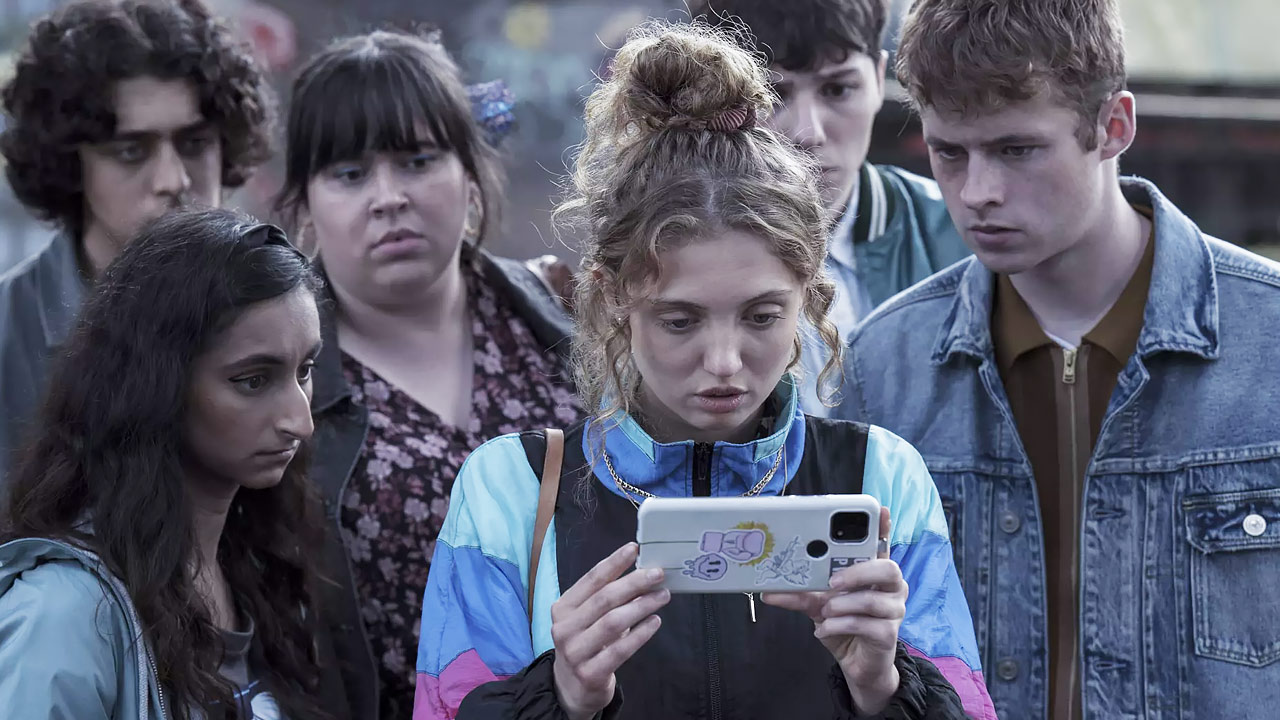Netflix horror series Red Rose cleverly explores the terror of tech-haunted teens

One of the most popular shows on Netflix at this moment is addictive British horror series Red Rose, which, writes Luke Buckmaster, is much more than a story about a horrifically invasive app.
A phone that watches you is one thing; a phone that acts on your behalf is quite another. Many years of hand-wringing about society’s intractable march towards Orwellian oppression and full-blown surveillance states led to a kind of grim, pathetic enlightenment, whereby most people accept Big Brother is indeed watching and view this as a consequence of modern existence. Subsequently the idea of simply being surveilled is no longer dramatically interesting. Reflecting this shift in consciousness, and proposing new things to scare the bejesus out of us, British teen horror series Red Rose joins an expanding canon of productions proposing that good old fashioned surveillance may be the least of our worries.
The show—which premiered on BBC late last year and has been given a second life this month, via an international Netflix release—features a villain of the times, and for the ages: a diabolically invasive smartphone app. The titular program preys on a group of freshly graduated North West England high school students such as Rochelle (Isis Hainsworth), who observes, when she first loads it, an augmented version of her own face—eyes sparkling, cheeks glowing—accompanied by text declaring “Welcome to the new you.” Soon she wants the old one back.
At one point the tormented teen props her phone up in a cathedral, and, watching it display an augmented reality-esque apparition coming up behind her, throws holy water at the device in an attempt to slay the ghost in the machine.
This is a fun, anachronistic touch, drawing a through-line from ancient practices to contemporary innovations, emphasising that everything and nothing has changed. As a standalone scene this offers appealing interpretive potential for Christians, shapeshifting ol’ Satan recasting himself as a cyber demon skulking around virtual corridors. But there’s the obvious question of who or what is behind an app that also sends messages and posts social media content on the kids’ behalf, has access to all their data, and directs them to particular places at particular times, often with a threatening message like “come here if you want to live” or “I’d hurry home if I were you.”
Is it a person? An algorithm? A malevolent spirit? All is explained by the end of the show’s eight episode season, which does a good job balancing the catharsis of plot reveals with the tension of not knowing. The fear operates on several levels, morphing and changing along with the fluid structure of the show, which opens with a death scene that feels a bit rote but establishes that stakes are high and fatalities inevitable.
An early part of the horror involves the characters learning they’re no longer in control of their public profiles and online identities—a very scary idea, memorably explored in Daniel Goldhaber’s doppelganger thriller Cam. Also scary is not being able to ascertain whether the app’s responses are human, or merely human-like: the Turing Test for the age of Zuckerberg, reconfigurated by Lucifer.

Some media commentary has, understandably, latched onto the show (created and written by Michael and Paul Clarkson) as a cautionary message about apps and privacy. The headline of a Mashable article for instance declares: “You’ll think twice about downloading apps after this Netflix horror.” But this perspective comes close to implying the take-home message is a kind of online abstinence—just say “no” to certain products.
The characters understand this isn’t an option. Attempting to stay away from all smart devices to avoid a potentially catastrophic event, Wren (Amelia Clarkson) notices, after shopping for supplies, CCTV cameras outside the supermarket, uneasily looking at them and clearly wondering whether Red Rose has access. In the rideshare home, she freaks out when she notices the vehicle is headed in the wrong direction. The driver’s earnest response is a great example of a line that’s eerie only in context: “I’m just going where the app is sending me!”
Combine Red Rose with corporeal tech-terror, such as Upgrade or Robocop, and you get a fusion of post-human inner and outer: the villain inside us; the villain around us. To argue Red Rose is chronologically positioned before the integration of human sensory systems with computers is to miss the point. In her book How We Became Posthuman, literary critic N. Katherine Hayles famously compared the Turing Test to a magic trick, relying on the acceptance of “early stage assumptions that will determine what you see later.” The crucial moment came not when the subject attempted to determine human from machine, but from the initial insertion into a cybernetic circuit combining represented and enacted bodies “through mutating and flexible machine interfaces.”
In other words: we’re already posthuman. That pronouncement will cause some to shake their heads in disbelief, as they gaze into the dim light of their smartphones or computer monitors. Red Rose warns us about being caught in a horrible feedback loop corroding or extinguishing individual agency and choice. We are told we cannot go back, but every foot forward is a step in the wrong direction.

















